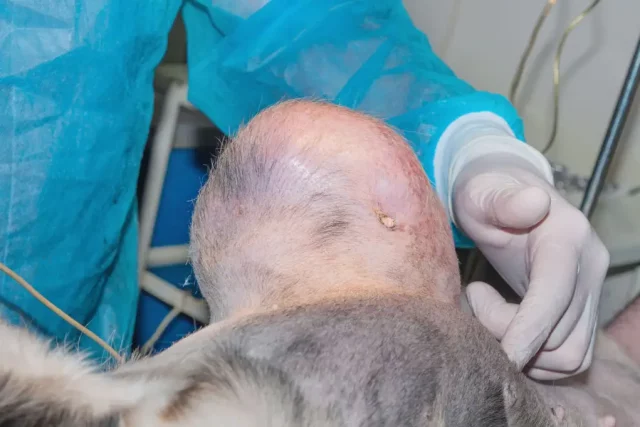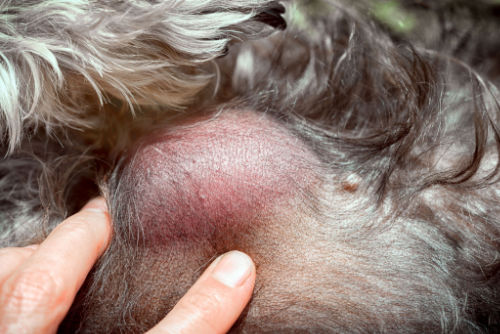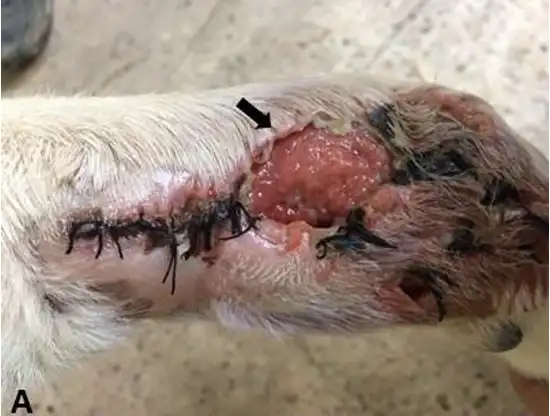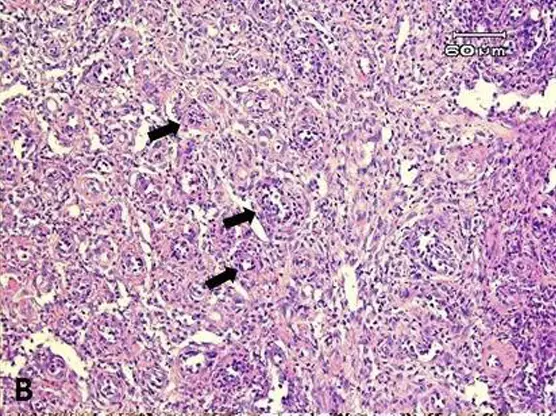
Table of Contents
We all want our dogs to be as healthy as possible, but sometimes diseases and illnesses appear without warning.
One of the most common cancers affecting our furry friends is hemangiopericytoma, yet it is not discussed much.
Are you ready to learn more about hemangiopericytoma in dogs and how to treat it potentially?
Follow along!

What is Hemangiopericytoma In Dogs?
To break it down and make it as simple as possible, hemangiopericytoma is a tumor directly under a dog's skin. Cancer typically starts developing in the limbs.
This type of cancer is tricky since it differs from other common cancers.
Unlike other tumors, it does not spread throughout your dog's body.
Although hemangiopericytoma does not spread, there is always a chance it will grow back in the same area affected after treatment.
Hemangiopericytoma develops when a pericyte randomly develops a chromosomal abnormality. This can be an extra chromosome or a missing one.
The cells affected are around blood vessels. Without treatment, hemangiopericytoma continues to grow.
Humans also develop this type of cancer. Actually, scientists first discovered hemangiopericytoma on a human, and four years later, researchers found it on a dog.
Large dog breeds between the ages of 7 and 10 have the highest risk of developing this type of cancer.
German Shepherds and Siberian Huskies are two dog breeds with a high risk for this cancer.

Symptoms of Hemangiopericytoma In Dogs
The most obvious symptom is a slow-growing mass. The mass typically develops in a dog's legs.
Not all masses look the same.
Your dog could develop a spot that is bald and missing fur, especially as it grows and stretches your dog's skin.
Other than an obvious tumor, it is a painful condition. Some dogs with hemangiopericytoma react aggressively and snap at their loved ones when in pain.
Sadly, our fur babies can't tell us what they are feeling directly. Instead, they whine and cry to get your attention and react to pain and discomfort.
It can also cause issues with breathing and digestion.
As the tumor grows, it compresses against organs, squishing the inside of a dog.
Usually, the pressure is on a dog's chest.
Whatever the symptoms your dog starts to feel, you should always take them to the vet if an abnormal growth is felt or seen.
While most tumors are benign, your dog has a better chance of beating cancer early when malignant tumors are caught early.

Diagnosing Hemangiopericytoma In Dogs
So, how does this cancer get diagnosed? The process starts when you notice the symptoms.
When an older large dog has a growing mass anywhere on its body, veterinarians will consider hemangiopericytoma.
However, the only way of knowing if your dog's growth is cancerous is by testing the mass through a biopsy.
A biopsy takes a small part of your dog's tumor. It is then examined carefully by professionals under a strong microscope to determine if it is malignant or benign.
It is not enough, though, to receive a simple hemangiopericytoma diagnosis.
Your dog's vet will still need to determine the severity, depth, and growth rate. Finding this out requires documentation.
Experts recommend documenting anything and everything related to your dog's condition, including non-tumor-related behaviors.
Your notes, coupled with further examinations using X-rays, CT scans, and MRIs, can help your dog's vet determine key information necessary for developing a treatment and management plan.
Potential Treatments for Canine Hemangiopericytoma
So, you have an official diagnosis; now what?
Not every dog suffering from hemangiopericytoma needs the same treatment plan.
The most common treatment, though, is surgical excision. However, it is only successful if the tumor is caught early.
Sadly, cancer can come back even if your dog's tumor is surgically removed, along with the surrounding tissue.
Sometimes, when the canine hemangiopericytoma is rapidly growing, radiation therapy is recommended.
Radiation therapy is highly effective, with a success rate of 80 to 90%.
When radiation therapy and excision do not work, your vet may recommend an amputation. This almost eliminates the chances of the tumor coming back.
Regardless of your dog's treatment, it is important to be fast and proactive.
After diagnosis, the average life expectancy of a dog with canine hemangiopericytoma is 2 to 4 years, sometimes less than a year in aggressive cases.
Hemangiopericytoma Dog Alternative Treatments
What about alternative, non-medical treatments?
There are hemangiopericytoma dog alternative treatments, but it is important to understand that no studies can verify they are effective.
However, desperate and loving dog owners try each year, and some have success alongside medical treatments.
The most common alternative treatment is herbal medications that are injected or swallowed.
You can also try changing your dog's diet to prevent cancer. However, there is no exact canine hemangiopericytoma cause, just risk factors.
Diet also plays a role, but no scientific evidence backs up these diets to help when a dog already has cancer.
While we don't know if feeding your dog, a new diet prevents or treats cancer, giving your dog new and more nutritious raw food isn't harmful.
Another common alternative treatment is a mixture of Chinese herbs. Although not as common, some veterinarians recommend acupuncture to help with relieving pain and shrink the tumor.
Hemangiopericytoma Conclusion
All in all, hemangiopericytoma is nothing to joke about. Whenever a mass suddenly appears anywhere on your dog's body, this should be a concerning sign that something could be wrong.
While not all masses or bumps are cancerous, it is better to be safe than sorry. This common blood vessel cancer can be deadly, especially if the tumor rapidly grows and harms inside organs.
But, with the right treatment, monitoring, and management resources, your dog has a great chance of surviving to live a long and healthy life.












